This post explains bicycle lock types, construction, and how to choose a good one for locking a bicycle. For instructions on “locking techniques”, i.e. how to properly lock a bicycle, read this post: Locking a bicycle.
Table Of Contents (T.O.C.):
- What makes a good bicycle lock?
1.1. Lock cylinder
1.2. Locking mechanism
1.3. Lock body - Padlocks – size and design
- Bicycle locks – types
3.1. Chain
3.2. U-lock
3.3. Cable
3.4. Folding lock - Two is better than one?
- Final notes
5.1. But I saw a YouTube video?! - Bicycle lock recommendations
1. What makes a good bicycle lock?
Chain is as strong as its weakest link. That is why it is important that both the chain and the lock itself be hard to break, or pick.
Some thieves like to cut locks, some break them, while others try to lockpick the lock cylinder, using special tools (this takes some skill and experience, depending on cylinder quality). It is impossible to tell what “kind” of thief will try to steal a bicycle, nor what tools they will bring. That is why it is risky, for example, choosing a lock that is tough to cut, or break, but has a weak cylinder, easily picked.
This is something people often do. Even when they pay a bit more to get a lock that is sturdier, they don’t go all the way (usually dobule the price of the weaker locks) to get a good cylinder as well. Or vice-versa, getting a top clas cylinder and key, but paired with a relatively thin (less expensive) chain.
Lock consists of the following three parts and they should all be of good quality:
- Cyclinder – part where the key comes in.
- Locking mechanism – part that connects and disconnects (the chain, or cable, or steel rod) when the key is turned.
- Lock body – casing protecting cylinder with the locking mechanism, and the chain/wire/steel-rod that locks.
1.1. Lock cylinder
Lock cylinder should be such that it is hard to pick. That means a good key and well protected mechanism. Combination cylinders are generally (not all) less secure, those with a key are usually better. A type of key tells a lot about the cylinder quality.
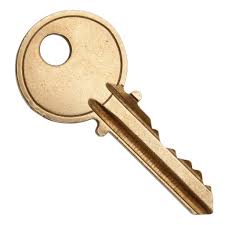
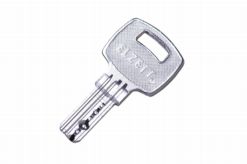
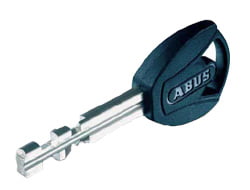
The last key (above, rightmost), for Abloy rotating disc cylinder, is one of the hardest to pick. If the lock mechanism is put deep inside the casing (like in the picture above), it makes drilling also a problem (anti drill plates are usually installed), which leaves the thieves to look for an alternative method: cutting, breaking, but the cylinder itself is usually a safe link in this situation.
1.2. Locking mechanism
Good locking mechanism should prevent opening the lock by force, while it is locked (enclosed).
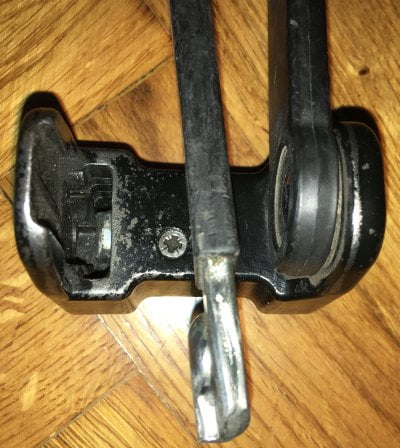
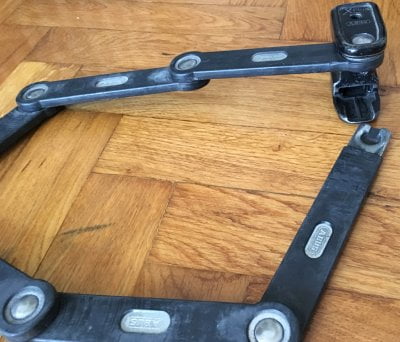
1.3. Lock body
Lock body is consists of a protective casing with cylinder and locking mechanism inside, along with a chain, cable, or steel rod(s) that are used for locking. Picture above on the right shows this – rivet connected steel rods that are used for locking and cubical steel case that protects the cylinder and the locking mechanism. Pictures below show the protection of the lock cylinder, from up close:
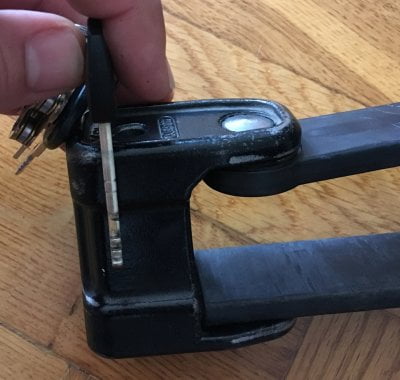
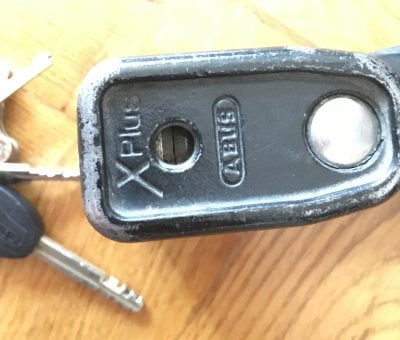
2. Padlocks – size and design
Things explained in chapter 1. go for all the lock types. In addition to that, when choosing a padlock, it should fit snugly around the chain, or cable it connects. For a thinner chain it is better to have a smaller padlock that fits tight, than a large one that leaves a lot of room to insert a craw bar and use leverage to break it open.
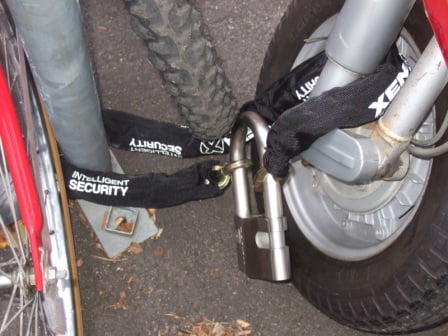
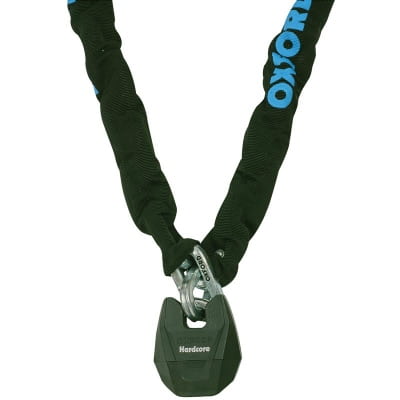
3. Bicycle locks – types
After explaining important stuff about locks and padlocks, it is time to explain bicycle locks. Bike locks are usually made and sold as integrated units combining a chain and a padlock, or a steel rod/cable and a locking mechanism with a cyclinder. There are four basic bicycle lock types:
- Chain (and a padlock)
- U-lock
- Cable (with or without it’s own padlock)
- Folding lock
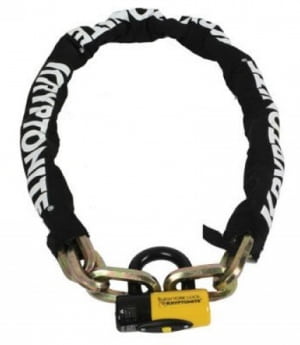
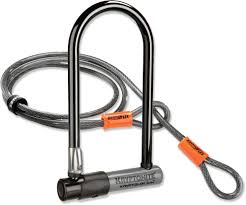

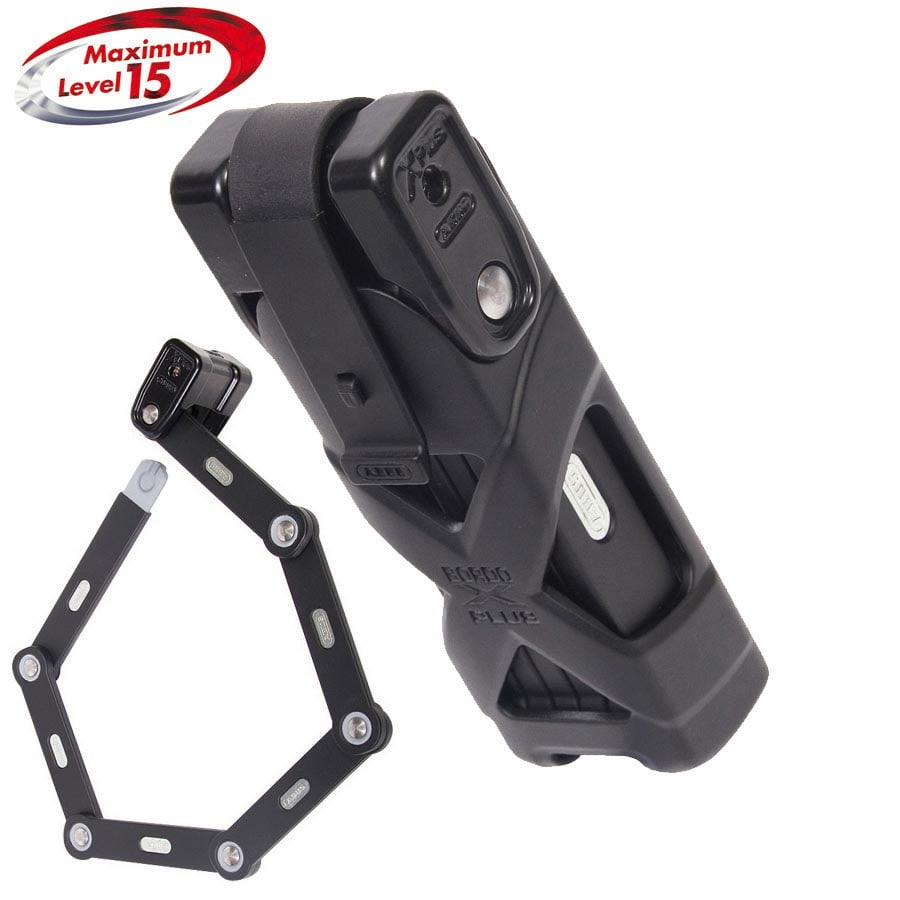
All the lock types are good. If one carries two locks, it is a good idea to combine a cable with one of the other 3 types. This because it takes different kind of tools for those locks: cables are usually cut, while the others are sawn, or broken (or cut if they are too thin, later on that).
Whichever type one chooses, it is important to make sure the lock cylinder and padlock (if the lock type has one) design are good – like explained in previous chapters.
Also, one should never choose a lock that is not heavy. Steel is heavy. If a lock is light, it doesn’t have (thick) enough steel. It is as simple as that. A good lock can easily weigh over 2 kilograms.
Steel hardness is another important factor. It is measured in Rockwell (HRC). Optimal hardness is 65 to 70 HRC. Good manufacturers give that information, while the less good don’t even know it.
Here is explanation of lock types with strong and weak points:
3.1. Chain
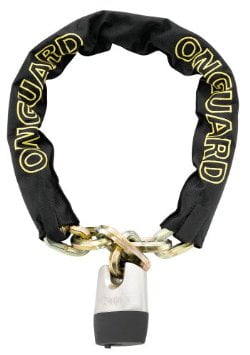
Chain should be of hardened steel, such that the core is hardened as well. It should be at least 10 (preferably 12 mm thick). Hexagonal profile (so that bolt cutters press on a wider area, creating less force per mm).
Locking mechanism and padlock should be as explained in chapters about cylinders and padlocks.
Advantages: Second most flexible lock type (behind cable). It allows easy locking around trees, through both frame and a wheel. You take a long chain and put it like you want to.
Cutting a good chain with an angle-grinder is difficult and dangerous (unless it’s held firmly in a vice, on a workbench). This makes it a lot more resistant to thieves with battery-powered angle grinders.
Disadvantages: weight. A long chain is often quite heavy. 12mm links and 1.5 meters long chain can weigh over 3 kilograms. Also, it is impractical to carry. Modern bikes have cables and housings all around and long chain needs to be wrapped around some part (top tube, or seat tube usually).
3.2. U-lock
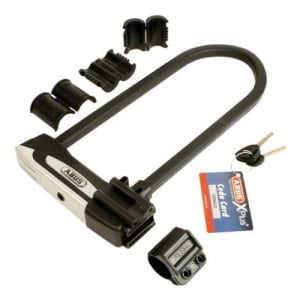
The same as chains, except here thickness shouldn’t be below 12 mm. Cylinder (key type) should be chosen like it was explained in the chapter about cylinders.
Advantages: lowest weight per level of protection. Moderately easy to carry (it usually comes with an adapter holder for the frame). Even without one it can easily be put on a bike’s rear rack (if it has one).
Disadvantages: THE lowest flexibility. To use a U-lock, one needs to find a post that is not too thick. Even then it can hold frame, along with one wheel if it is close enough.
3.3. Cable

I’d recommend it as an additional, next to one of the other lock types.
So, it’s not a good main lock, but a backup, for securing wheels and similar.
The thicker the better. 10 mm is minimum cable thickness. With a good padlock or attached to another lock for keeping it closed.
Advantages: the most flexible, easy to carry.
Flaws: easier to cut than other lock types. Good as a backup lock.
3.4. Folding lock
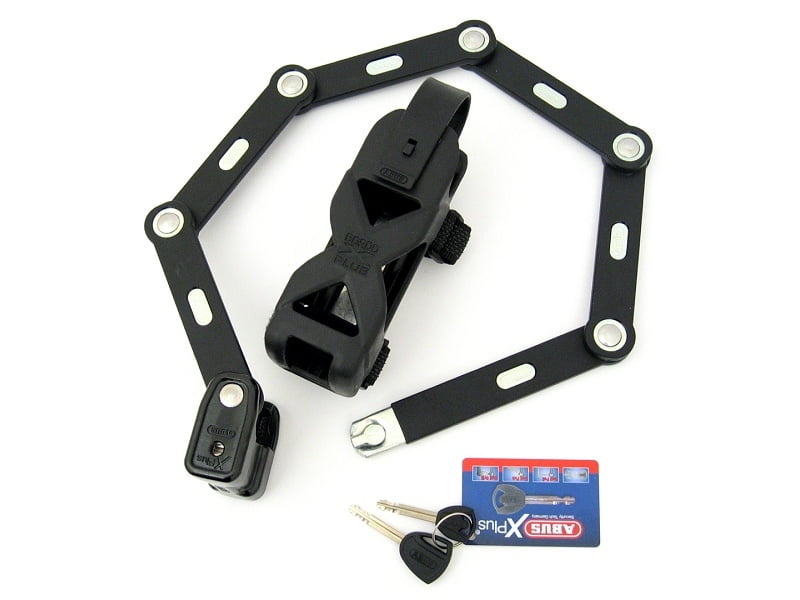
Made of several steel rods, riveted together. Here dimensions and thickness are not that crucial. If it is made by a renowned manufacturer with a good cylinder, and strong rivets, then it is just slightly less secure than a 10 mm thick chain or a 12 mm thick U-lock.
Advantages: among the easiest to carry (comes with a frame mounted holder). More flexible than a U-lock.
Disadvantages: limited flexibility. In spite being better than a U-lock in that department, one often finds themselves wishing for just 10 more centimetres of length, or just a bit of flexibility to the sides.
4. Two is better than one?
The claim is often true, with one big “but”. Two good quality locks are better than one good quality lock. If, however, instead of one decent lock (that is hard to cut, or pry), two cheap, easily cut locks are chosen, that will hardly improve theft protection. It is always a good thing to have at least one really good lock, with an additional lock (for locking wheels for example). Cable is a good choice for a second (back up) lock. Use the better lock to lock the bike’s frame to an immobile object, and the weaker lock to back that up, or to lock the wheels so they too can’t be removed and stolen.
5. Final notes
People are often not prepared to pay more money for a good quality lock. The explanation is usually something like: the bicycle is not expensive, so there’s no use for a lock to cost as half the bicycle’s price. This post author’s advice is: buy a good quality lock once, or you will be buying another (even if it’s cheap) bicycle every month. Good locks cost about 50, or more euros, but last for decades, as well as the bicycles locked with them.
Of course, even a well locked bicycle with a good lock takes just about 20 minutes to hack. If the thief uses a battery powered angle grinder, it is just a few minutes “work”. So no method is 100% safe. However, if a bike is better locked than the other bikes in the street and it doesn’t look more expensive, there is a much greater chance it will wait for you where you had left it. The fact that any lock can be hacked is not a reason to buy a cheap, poor lock, because it’s not all the same for the thieves! The more time and noise a lock takes to beat, the more likely they are to look for an easier prey.
In contrast, cheap bad locks, poorly locked bicycles are taken within a minute or less, with ordinary tools every small thief has, or even without any tools.
I’ll add a short story here – to emphasize the importance of having better protection:
Two friends are preparing to go for a walk in a forrest. One of them puts on some running shoes. His friend asks:
“Why are you putting on the running shoes?”
– Oh, that – in case we encounter a lion.
“What – you think you can outrun a lion?”
– No, I would just need to outrun you.
So, unless someone decides to target your particular bike for some reason, as long as it looks cheaper and is better locked than the others, it’s quite reasonably safe.
5.1. But I saw a YouTube video?!
As I have tried to explain in this post and in chapter 5, 100% secure system is unusable – by definition. The point is to make a bicycle better protected than the other bicycles. Yet, every now and then, I hear comments and am shown (usually YouTube) videos, where people break all kinds of locks, including the good quality ones.
Bad locks are cut within seconds using small cable cutters, or picked within seconds using improvised tools. That is true. But here I’ll discuss the videos where good quality locks are “broken”:
- For a lock-picking example, I’ll use the video made by LockPickingLawyer with Abus Granit X-Plus U-lock. Someone saw the video and commented how that lock is easily picked. Well, the video’s author is an experienced expert in this field, with all the proper lock-picking tools. As he himself says at the end of the video: “… I do think it has enough pick resistance for securing a bike in the street.” In other words: I know of only two people who have the knowledge and the tools to pick these kinds of locks (not saying there aren’t more, but when I was doing research for writing this post, I couldn’t find them). To them it is not profitable to do crime, especially not bicycle thefts.
- Using bolt cutters videos: if a lock is a good quality one, bolt cutters used need to be of high quality, with very long handles for leverage – such that don’t easily fit under a jacket, or in a backpack of an average bicycle thief. Also, ground is often used as a leverage for one handle of the cutters, so the whole weight is put into the cutting. My post on how to lock a bicycle explains why locks should be placed away from the ground whenever possible.
- Battery (cordless) angle grinder example: powerful tool, will cut almost anything rather quickly. See this video of using a cordless grinder on an Abus chain. The chain is held tightly in a vice. All the protective gear is used. See how much noise and sparks this produces – and it’s still not just a 5-10 second job. Not even with the expensive and good quality cordless angle grinder. Imagine having no vice, so that the other hand needs to be used to hold the chain/lock in place. Besides, time goes slowly when stealing, watching if anyone will come, so thieves are very likely to choose easier targets, even with tools like these.
- Good quality hand saw: 20 to 30 minute of hacking gets through most chains. Poor ones are cut in a minute or two. Thieves don’t like hard work and prefer easy prey.
So it’s no secret that even the best, most expensive bicycle lock can be broken. It’s just a matter of how much time, knowledge and tools are needed to do it. That’s why it’s not irrelevant whether you use a good quality lock, or a poor quality one.
My video presentation of Abus Bordo 6500 lock, with a bit longer talk about locks and bike security in general, and about the LockPickingLawyer YouTube videos:
This is the main point. A lock that LockPickingLawyer says the lock he uses for his bike opens rather quickly, but he concludes: “…I suspect this would be well beyond the skills of the average bike thief…”. Link to the LockPickingLawyer video. During the video, he explains his philosophy, and it doesn’t differ too much from mine. He says he uses a chain lock model Kryptonite Evolution Series 4 (Amazon affiliate link), and it looks quite good, but I haven’t seen it live, so can’t personally recommend it, but it looks very similar to Abus GRANIT CityChain XPlus (affiliate link).
6. Bicycle lock recommendations
Pictures below are my recommendations for good quality, safe bicycle locks. If you’ve carefully read the previous chapters, you’ll probably understand why I’m not recommending anything cheaper. Manufacturers won’t sell good locks, with good (confirmed) reputation, cheaply – when they can sell them for more. Cheap locks are usually, from my experience, either of poor quality, or with no confirmed good reputation. When it comes to things like safety of a locked bicycle, I’m not willing to take risks, even less to suggest to others to take a risk, just because a lock seems like a good one to me, without testing it first. The moment I find a cheap lock that is not easy to open, I’ll be the first to buy it, try it and recommend it here on my website.
Clicking on an image below will take you to Amazon.com online shopping (as an Amazon Associate I earn from qualifying purchases), or you can buy them locally.
All the listed locks are made by Abus. Simply – for those I could get info on HRC hardness, locking mechanism, and I’ve had very good 1st hand experiences (with the listed, not all the Abus lock models are recommended!).

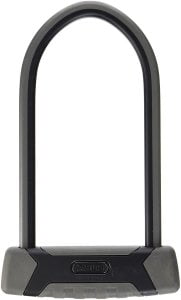
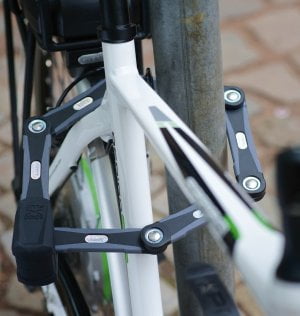

Good for locking wheels and accessories, but not as a “main lock”.
For people living across the ocean from Germany 🙂 it is probably cheaper to look for Kryptonite locks (Amazon affiliate link) – from what I could see and hear, they have good models, and are a lot cheaper than Abus in the USA, but I haven’t had much 1st hand experience with them. Not saying they are bad, but can’t confirm they are good either.
Video demonstration of bicycle locks I’m using and would recommend:
Related post – How to safely (properly) lock a bicycle:


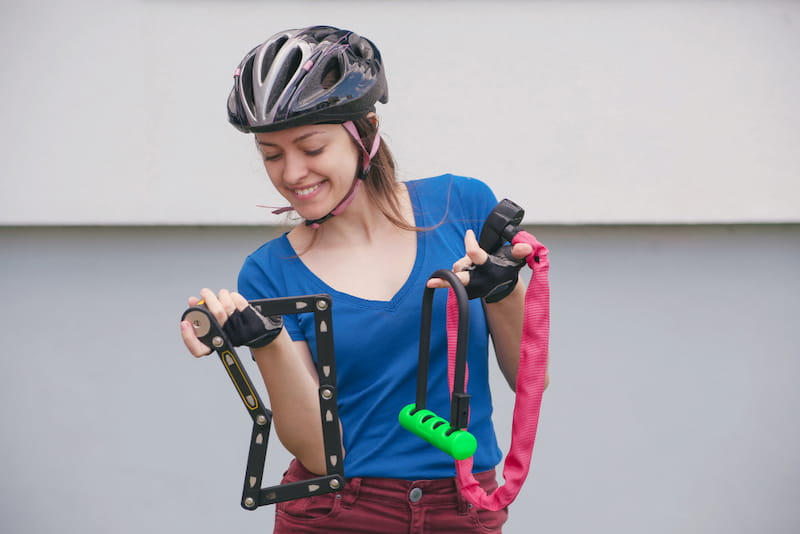
I’m waiting for a u-lock that consists of a hard steel core covered by a reasonably thick aluminum layer and a heavy Kevlar sock.
I don’t expect it would be heavier than the current all-steel models and would resist grinding (aluminum clogs the grinding wheel) and be impossible to hacksaw without removing the Kevlar and getting through some hard steel.
Dear Relja,
Since you want “the Bike Gremlin project is to be(come) a hub for objective, complete, thorough and correct information” I will not be shy with the length of the information presented below:
Thank you for taking your time to watch/listen to what I had to say in my video(s). Now, I discovered your article on bike security and I quite like it. I resonate with the way you present information. Smart man!
13 more Bike locking points that I’ve missed because my reply-video ( https://youtube.com/playlist?list=PLpaz2DYuUNjLRnRnSvxhLT9K5Q9RnGHKV) was spontaneous, unprepared and was getting too long and I hope you could address (at least some of) them in one of your future videos. I hope the long text below won’t bother you and maybe it will be useful for someone. I am now at a computer, not stranded in the car like yesterday, and I am writing in word. I hope I could post the information below as a comment to your article so I did not bother with any images. Otherwise I will send this to you via e-mail.
1. More locks are better but too much can be too much.
The amount of bike locks that a potential thief would have to cut/saw/destroy can be too big if the object that the bike is secured to is weaker. Sometimes you just can’t find enough strong things to secure the bike to… and most of the times the bike racks are made from 10 – 15 mm regular steel or cast iron or aluminum. If having multiple locks only engages the same elements from a fixed structure, it would just be easier for someone to cut that bar of the structure and not deal with all the locks. So a balance is to be made. Probably more than 5kg of total locks will not bring any extra security and from a certain point it becomes really impractical to carry all that dead weight all the time. Really, with so many locks it would be very difficult to find something that is actually more difficult to cut or brake compared to all the locks together.
Of course a Kryptonite U lock will better secure the front wheel compared to a cable, but only that is 2kg… it should be a main lock.
2. Security rating
Bike locks usually come with security rating something like 7 out of 10 or 15 out of 20. Linked to the previous point, it is of course preferable that you pick the highest rating that you can afford. Also, buyers should pay attention that a lock from a serious manufacturer usually has at least 2 rating scales: their own internal scale which shows you how it compares with other products from their range and also some rating from a third independent party institute which shows how the bike rating compares to the others on the market. These independent party ratings are Sold Secure (UK), ART (Dutch), CNPP (France) and maybe others. The most commune used is Sold secure. The idea is that those who wish to have a bike insurance against theft get better deals if they prove they are using a bike lock with a certain rating from Sold Secure for example. However, these ratings are not 100% accurate, they are just for orientation. In some situations I have noticed highly rated locks such as the Hip Loc (Litelock) or the TiGr lock ( Bosnian Bill tested it and put it to shame sawing it in 10 seconds with a 5$ hacksaw: https://www.youtube.com/watch?v=WZ0UCzi0Tpg) which had high ratings but youtubers made it clear that they can be broken (not picked) with relative ease with the right tool. I especially love how the Lockpickinglawyer puts to shame the hip-lock https://www.youtube.com/watch?v=D-On0DGcDlc.
3. Location and pedestrian traffic
As a general advice, people should pay attention where they leave their bikes. It is preferably to be a crowded high visibility area, not on a back street. Never leave the bike unattended at night, no matter how much you secure it, how much it has video surveillance, there is nothing to stop a thief with time and the cover of darkness. Such habits would just give more time for the thief to find some method…. Even go to his home to bring more tools or friends or vans.
Another point regarding location is that you should try to lock/attach your bike to something in such a way that nobody will stumble upon it. Don’t put it in the middle of the road because it might get damaged either by accident if somebody trips, either by vengeance, if somebody is not happy about the position, if it is an unorthodox position, not a specific bike rack.
Also, even if I touched this in my video reply (and you a bit in the second article), I’ll bring it on again because it really hurts and troubles me: 80% of public bike racks are no good! At least in Romania! Probably in Serbia it is the same as I feel our countries are sisters. Only in the Netherlands I have seen correct bike racks designed for bikes. In most of the cases, in reality, it looks like the bike racks that are available in public places, installed either by city administrators (rarely) or by some larger shop like Ikea or Carrefour or something like this, those bike racks were not designed by somebody who understood bikes, were not bought by somebody that understood cyclists. Probably someone in the acquisitions department had to fill their budged for the year and was told to buy bike racks. Those are designed to be mounted in a private and secure yard, where let’s say a collector has 10 bikes and wants to park them in his garage… But not for usage in the public space. Why? Because they are lower than my knee and they only allow for the front wheel to be installed. And 90% of cyclists are like sheep and they install their bike like that with a 3$ cable lock. Great! Sometimes those public bike racks are not even secured into the ground, you could lift them! Or they have 4 x 13mm hexagonal bolts or something really easy to take them off the ground. Sometimes I park my bikes in reverse, to be able to clamp the rear wheel and a seat stay to those low bike racks, but sometimes there is not enough space. Sometimes I secure my bike at the end of such a rack, to be able to secure the frame. And sometimes I get protests from security agents or other users that I am using it wrong and I should use it by the front wheel because I am no more special than others. In many situations I prefer to find a fence or a pole and make sure it is stronger than all my locks combined. But if you link your bike to a private fence, the rightful owner could legally cut your lock out of his property.
Speaking of location, in an ideal situation, try to find some place where some CCTV camera is covering so maybe a potential thief would be discouraged. Although, nowadays, with Covid Masks and craziness anything could happen.
So, picking the right location to leave your bike is JUST AS IMPORTANT as the locks that are used.
4. Sheldon Brown locking method
(I actually wrote this text before discovering your second article on how to lock a bike, but since Sheldon is a legend, I am going to leave it, and both of us believe that he was a legend 😀 )
I always try to use one lock for as many parts as possible For example frame + rear wheel combination. Sometimes you only have one single lock and might not be enough so try to secure as much of the bike as possible. If you only have a single lock it’d better be a U-lock, preferably Kryptonite Fahghetaboudit (whatever spelling) . Now, a U-lock can be too short or too narrow and it might be difficult to attach on it the frame AND the rear wheel (which is more expensive than the front wheel).
The LEGEND Sheldon Brown promoted a method to secure with a U lock only the rear wheel inside the rear triangle and even if the rear triangle or frame is not specifically secured directly by the lock, in order to get the bike out, the thief would have to cut the rim of the bike, otherwise, even if you unscrew the axle of the wheel, the frame would be stuck. And probably 99% of thieves would prefer to have a ridable bike with a full set of wheels.
Now, if the rear wheel has a Rohloff speed-hub or a fancy rear motor or something of value, it would still probably be worth it so this might not be enough, more security would be needed.
5. Wheels can be swapped between bike by thieves
Because not all cyclists are capable to secure both their wheels and only lock the frame, many times, a thief could find a bike which is secured only by the front or rear wheel and with a free frame, take the bike with 1 wheel, and find another bike (same wheel size) which is only secured by the frame and get the missing wheel and ride away.
There are some anti-theft fasteners for the wheels so you could only take them of with a special key with a certain very rare geometric model, but I am not that well organized in my tools and I think I might lose the special key and I would also live with the fear that some thief could have a set of such keys to try on my wheels, so I am not a big fan of that, especially since I have 7 bikes. The Quick release or the 15mm spanner is better for me.
6. The Frame Locks (O-locks)
You said nothing about my favorite underdog in bike security: The Frame locks which by themselves they don’t provide a good deal of security because in theory someone could walk along the bike with the locked wheel lifted from the ground or dragging… but that would take effort and could rise suspicion on the streets, in case they encounter a capable police agent, and it is difficult to move fast, unless they have a van. But, that O-lock will work a bit like the Sheldon-Brown method and make it much harder to remove the rear wheel (in case the thief could replace it with other wheels found on the street from improperly secured bikes). The downside of these O-locks is that the owner forgets about them and tends to push his own bike and might damage the spokes.
But, O-locks in combination with plug-in chains are much safer. For example, my Axa Defender internal safety index is 12 out of 15. In combination with the plug-in chain (NOT CABLE!), the rating goes to 15/15. However, on my personal imaginary scale, I would rate it 7/10. And if you use a plug-in chain, it is easier to notice that the lock is ON when you need to ride again so no more spoke impact.
The GREAT advantage of a plug-in chain in combination with the frame lock, compared to a pad-lock and chain is that the in the case of padlock the chain needs to form a loop in order to meet again with the lock so you effectively enjoy only half of the chain (which is heavy) length! With a plug-in chain, you can take advantage of the entire length. Sometimes (depending on position and shape of objects and bike size), after securing a bikes frame to a pole, I use that chain to go around the pole and grab with a loop-knot the front rim, which excludes the need for a front wheel lock, which would be an inefficient cable.
7. My general security scheme ABCD
Recommendation, better explained and will not guarantee anything.
A. Main lock – Heavy folding lock or heavy U lock (usually have supports to be fixed on the frame). The main lock needs to secure the FRAME in some loop, like the rear triangle and if possible the rear wheel too.
The main locks I use are Abus 6450 OR Btwin Elops 920 (this does have a disc detainer core so it is pretty secure against picking. The key is similar to the one from Abus, except no LED light).
The U-lock that I use:
Decathlon UK: https://www.decathlon.co.uk/p/920-bike-d-lock-25cm/_/R-p-145313?mc=8331481
Or Decathlon SRB: https://www.decathlon.rs/brave/145313-1363-d-lock-brava-920.html#/demodelcolor-8331481/demodelsize-235no_size?queryID=ac375bf3b2afd7464071008747dbf5b8&objectID=632157
The Abus 6450 that I use:
Decathlon UK: https://www.decathlon.co.uk/p/bordo-granit-x-plus-fold-away-bike-lock/_/R-p-X8385907?mc=8385907
Or Decathlon SRB: https://www.decathlon.rs/brave/998385907-49869-sklopiva-brava-bordo-granit-x-plus-6450slash85.html#/demodelundefined-8385907/demodelsize-254?queryID=3a5635248dabb49e80d7b7c09e3430ac&objectID=2209694
(1.6kg each)
I would like to have instead the Kryptonite Fahgettaboudit but that is too expensive for me and sometimes too rigid in options, having a small opening. It is also heavier at 2kg.
B. O-lock/ Frame lock with plug-in chain (O-Lock is fixed and the chain needs to be wrapped. I made a wire hook below the saddle and I hang and wrap the chain on the seat tube. The O-lock will add extra security for the rear wheel and the chain will make it even more complex to be cut, especially since it is not quite compatible to angle-grinders so the thief would have to bring more tools both for the main lock and for the chain.
On a folding bike I have, I decided to put the O-lock on the fork, because I think it provides even more security for the front wheel compared to a simple cable and the main lock can take care of the frame and rear wheel in the same time.
The O-lock is available at Decathlon:
Decathlon UK: https://www.decathlon.co.uk/p/defender-bike-frame-lock/_/R-p-X8392574?mc=8392574
Decathlon SRB: I can’t find it… I don’t speak the language and in the search bar nothing with AXA products
AXA link (they call it a Ring lock apparently): https://www.axasecurity.com/bike-security/en-gb/products/Locks/8/556651954405SC/axa-defender-retractable-black
The chain is no longer available at Decathlon so I will only show a link from AXA: https://www.axasecurity.com/bike-security/en-gb/products/Locks/8/59561196SS/axa-dpi-110-9
(640g for the O-Lock and 2040g the chain so 2,7 kg for the secondary lock system)
Abus also makes great quality frame locks with plug-in chains but I’ve never tried any.
I can’t state this enough:
I do not recommend the AXA plug-in cable. Only the chain. In the case of the cable, probably a thief with sharper teeth could chew it!
C. Cable to secure the front wheel – If no other above metod is available. If the O-lock is on the rear wheel as normal people have it, I prefer a combination cable with a higher quality combination shackle for the front wheel. As for the cable itself, 10mm thickness to secure the front wheel. Cables can be easily cut with a single hand pliers cutter…being as resistant as only a single wire from their structure and probably somebody with strong hands and skill could cut a 10mm cable in less than 30 seconds.
Decathlon UK: https://www.decathlon.co.uk/p/120-bike-accessories-combination-cable-lock/_/R-p-129013?mc=8168164
Decathlon SRB: https://www.decathlon.rs/brave/129013-4792-spiralna-brava-sa-sifrom-120.html#/demodelcolor-8168164/demodelsize-254?queryID=0200781599e010cda5f59889bdea59c6&objectID=1319918
For a cable lock, it is heavy. And the declared security level is 2 out of 10. So NEVER expect much from cables by themselves! It will only make the job of the thief slightly more complicated, hopefully enough to move on to the next bike target.
(590g) – I like it because the combination is programmable so each user can set his own individual 4 digit code.
D. Secure the saddle, usually by cable – this is such a Pandora’s box because I wish the saddle had some retainer in the frame so I could avoid another lock. But most seat-post clamping is by Quick release. To avoid this, I sometimes use a hex Allen key screw with a ball bearing super-glued inside (removable with acetone). But… on a folding bike, you need to have a quick release seat-post because you always compress the seat post while storing it.
For the saddle lock the product that I use is called “Kross KZS 110”, It is pretty obscure, it was hard to find and I chose it because I wanted a narrower cable to fit between the saddle rails, I wanted a combination locking system and also I wanted to have letters so it would be a different combination instead of the one I have for the front wheel, with numbers. So I bought it from a local website. The “international” manufacturer’s website is: https://kross.eu/en/accessories/accessories/locks/lock-kzs-110
I don’t know how much it weighs but I suspect max. 200g. – Unfortunately this one has a fixed combination and the user needs to remember the letters. Fortunately, in my case it is a 4 letter actual word so no big deal.
In the article about how to lock a bike, you say “ Saddle can remain always chained to the frame, wherever the bike is ridden.” But I can’t always agree. First, it looks ugly and if you love your bike you want it to look beautiful! so that cannot be permanent. Second, if the bike is folding, and the seat post needs either to come out either to go to the bottom to facilitate storage, a cable, due to its stiffness might make life hard if it is permanently attached.
You call the cables the most flexible but in my experience I really hate them because they are the opposite of flexible. They are liars. Cables make you think they are flexible but instead THEY BEHAVE LIKE THEY HAVE A MIND OF THEIR OWN because of their internal stiffness. It is fiddly to make cables to follow the geometry that you want. Yes some can be longer but such a hustle to thread them between the spokes or the rails, always have to pull them and being coated in rubber they get stuck with a lot of friction on every bend they follow… I just use them for their single advantage: weight. They are light! Also, from a visual point of view, 90% of thieves might back off since they would rather steal a bike with fewer locks. That’s it, no flexibility. I even prefer to install U locks. At least I can visualize the geometry and I can plan in time how I am going to put it. In the case of the cables, you really have to improvise on the go.
On the internet, there are way too many pictures (even in your article which I have just seen and read “How to lock a bicycle” https://bike.bikegremlin.com/434/how-to-lock-a-bicycle/ )with frames which are chained to some pole but they are stripped of everything: wheels, saddle, brakes, derailleurs and shifters, sometimes even the handlebars and the stem. The fork is left behind only if it is a simple steel fork. Some thieves are like Piranha fish – leave bare bones.
You might have noticed that many of my products come from Decathlon. I do not intend to make advertisements, it is only because in my region, for me, they sell quality products at reasonable prices, there are many shops available in main cities and I usually don’t like to order from the internet. I prefer to touch the product myself before paying for it. And dedicated bike shops tend to have fancy-smency products that are more expensive for no reason.
So the total lock weight that I carry, on a regular basis is pretty big: 1,6 + 0.6 + 2 + 0.6 + 0.2 = 5 kg!
Honestly, this is the first time I calculate it, because so far safety was more important than weight and this is the only way I can stay chill when I leave my bike outside for too long. Also, I use this on my electric (compensates for extra weight) folding bike (guess the shop) or on a Batavus Dutch bike which is 18kg anyway being a city bike. On Mountain bikes, I admit I only carry a cable for a quick stop to buy some coca-cola from a shop but if I am on an MTB I will not leave it unattended for more than 1 minute and always locked.
8. Nobody cares about your bike
Never expect that regular people and pedestrians might pose a threat to thieves. If the thief has tools, especially a hand electric angle-grinder, nobody will argue with him ( or her ) ) People just don’t care. 90% don’t even notice that somebody is screwing with your bike and out of the remainder 10%, 9% will be too afraid to do anything. Chances for that 1% good-brave-strong Samaritan to be there and chase away the thief are minimal. Thieves do not have shame, this is their job, for them it is just a step in the process if some passer-by starts to argue… and chances are nobody will do anything. Also, thieves are smart, they many times dress like cyclists with helmets, gloves, reflective vests, food delivery back-packs (where they keep the tools), and they blend really well in the landscape while working on the bike, even their body language can cover up for the real action. Your bike is your responsibility and your own only! Even police can be too fat and lazy to do something…. That action might just require some more office paper work and maybe they just need a nice day in patrol.
However, I really want to encourage the following attitude amongst pedestrians: PLEASE, if you notice somebody is tempering with a locked bike and pretends they’ve lost the key, go to them and show them your phone as if you are taking a picture, maybe even take a picture, because it is a public space, it is allowed. Tell them that you are going to post the picture on the most popular Facebook bike groups in your city so that the picture would go viral, and if the bike is reported stolen, the owner might see the picture and go to the police. If he is the real owner, he might even show you his ID, to calm you down, but if he is a thief, he will either run away either threaten you, in which case you run away and ask for help.
9. Chains are too heavy to be practical to carry
Chains are difficult to cut with angle grinders because they cannot be fixed. But in order to resist bolt-cutters, their link needs to be HARDENED, hexagonal or square and at least 10mm thick. Also chains are long, about 1 meter or more and all this adds up to a very heavy lock, maybe 5 kg (with a healthy padlock). Which is totally impractical to carry all the time. There are some images with New York couriers who use such chains as belts with a large padlock in the middle of the belly, but I wouldn’t ride like that. Nonetheless, chains are good as a stationary lock, for example at work or at the train station if you go there every day, you might leave such a chain. It is also very expensive but it might worth it.
I need to point out that the article mentions that from the flexibility point of view chains are inferior to cables. I do not agree. Most cables are looped in a spiral and it is a really hustle to wave them between the spokes and narrow frame elements where as chains are more straight forward and are easier to install or retract from their position. Even those loop-ended cables, they have some stiffness while the chain will bend with zero friction and internal stress whichever way you want and won’t twist in it’s natural direction because there is none. Gravity is the only force that influences the chain position.
So the chain is the absolute most flexible type of lock from the geometry and phisics point of view, especially the plug-in chain.
The chain paradox: heavier does not necessary mean more secure. It could just mean a useless length. So if you see a 3kg chain, pay attention to the size of the link which should preferably be a square section.
10. To be avoided. What not to do:
In order to keep your bike safe, please avoid the following bad practices:
– Leave bike unattended and unlocked if you are more than 10 seconds away
– Lock the bike only with the café-lock, even if you are close but you can’t actually see it permanently
– Use only cable locks which become main locks
– Secure the bike by the wheel(s)
– Use U-locks that are fixed only on a single side. They must be double-sided retained to avoid twisting if someone manages to perform a single cut. Thus, they will require two cuts and double the time and effort of the thief.
– Use U-locks that have the shackle outside the direction of the arms. This will expose the shackle to brute force attacks with hammers or pneumatic guns such as the ramset from Lockpiking lawyer.
– Use folding locks if they are less beefy than Abus6500. Smaller folding locks are just expensive, nice looking but not efficient at all.
– Use locks that are made from non-hardened steel. If you don’t know the final hardness from the specs of the lock, you can try to use a metal file to scratch it. If the file leaves a groove, go away from that lock because it will be easily cut or sewed and it is not worth the money, maybe for aesthetic reasons. Also I need to point out that hardness (the ability of a surface to resist scratching) is not only measured on the Rockwell scale (HRC) as stated in the article but some measure it on the Vickers (HV) scale, some measure it on the Brinell scale (HB), so in order to correlate those numbers to the 65-70 HRC mentioned in the article, the user needs to find some corresponding tables on the internet.
– Use locks which have the core with plastic inside to retain the mechanism. Plastic can be melted with a pocket torch blaster.
– Use cheap locks. These have easy to pick cores. It is preferably to use disk detainer cores as they are much more pick-resistant. Still, try to find some video of someone like the Lockpickinglawyer to see how easy it is for something to be picked. If it only requires the undulated wafer wire and some jiggling, avoid that product. Some cheap ones can be opened with toothpicks or paperclips. Avoid those as well. Go higher in the market.
– Use number or letter combination locks as main locks. Average skilled thieves should be able to find the code in less than 5 minutes. Maybe even faster, depending on the quality. For cheap and low quality, average thieves only need 1 minute.
– Forget to secure the saddle and wheels
– Forget to take off the bike removable accessories such as lights, computers, and others that do not require tools.
– Forget to check if the object you use to secure your bike is well fixated to the ground and if It is a pole, make sure nobody could lift the bike over it.
– Rely on public security to take care of your bike
– Use your bike at night without cat-eyes and operational lights. This is not about stealing but still it is about the wellbeing and general security.
– Lock your bike to trees if they are narrower than your legs. I have seen thieves cut trees to steal bikes and from an ecology point of view it is a shame to endanger them https://www.youtube.com/watch?v=PcV4LVhSRLg.
– Lock your bike to a wooden bench by the wood rails (such as backrest)… only if it has a closed metallic structure. Also, public benches might not be the best solutions as some pedestrians might want to use them and be reluctant when they see a bike, even if the bike does not block the seat of the bench.
– Lock your bike on a wire frame/fence. I have done it sometimes but I made a large loop so the potential thief had to cut 15-20 wires to free it and fatigue would have taken over his hands. Still, not a good idea.
As you see, a lot of DON’Ts to remember but most of them are common sense.
11. Big folding locks like the Abus6500 are great in self defense in extreme situations.
The folding lock can be used as a hand weapon, such as a baseball bat or as a whip if it is extended. This might sound funny/stupid but if you are in a bad neighborhood or somebody stops you and you need to defend, just get the folding lock, grip it by the 2 middle links and use the shackle to hit your attackers. Of course, this can be used to do harm, which I am against, so please don’t smash cars or windows or the heads of non-guilty people with such a technique and also it could be lethal so might involve years of prison if you hit somebody in the head, maybe except for self defense situations. But in a limit situation, in a survival story, where let’s say 3-4 guys in the middle of the night stop you cycling and threaten you with knives, it could be a last resort. The advantage of a folding lock as a weapon (big Abus ones such as 6500 or 6450 – 1.6 kg) is that is very easy to be deployed and get out of the frame holder (does need to be opened by key for this). My guess would be that 90% of such people with knives from bad areas who could attack at night would back off when they notice that the victim has a decent method to retaliate and hopefully the conflict could be avoided.
12. Other locks can help with self defense as well.
I have even seen angry drivers get out the cars, together with their passengers and start beating a cyclist due to some traffic misunderstanding. Physical aggression is a risk worth considering.
Multiple types of locks could be used as weapons for self defense in the extreme situation I described previously. For example a U lock (which even has some hand guard like swords) or the chain lock if you spin it around. So in case of an emergency the role of a bike lock might be double, not only save a bike but save the owners life. Most attackers won’t expect the cyclist to be able to defend himself and the shock of that would probably make them look for somebody else or go home to mammy.
13. Last considerations
I’d also like to mention here that most bike security experts recommend a U-lock with an internal area as small as possible, which in theory would leave less room for the tools of the thieves. In reality though, less room in a U lock means less chances for GOOD possibilities to secure the bike as not all poles are thin enough or allow the frame to be close enough or cannot go around the rear wheel as well, so in practice, I prefer a larger U-lock. Better to have a larger lock and something to lock to, than a small lock and nothing to secure the bike. Chances that thieves would use crowbars or hydraulic jacks are low and if the security system is composed of more locks, only one of the mentioned tools won’t be enough.
There is also that Ramset pistol that Lockpickinglawyer mentions in some videos, which propels a small ram with high velocity, with some compressed gas I think (or gun powder cartridge) (I have never seen such a tool myself and I like to be informed about tools), and when that is hitting the locks, most of them fail, only the largest ones stand a chance. For this purpose it is advisable to use a U-Lock where the arms are in the same line as the body/shackle, and avoid the ones with a larger body, which is just a point for the ramset pistol to hit and brake.
P.S. – of course I’m not done yet…
I have seen your video about how to mount on the frame the clamping holder for the Abus6500. To avoid thieves you have used both methods: screws and the straps. I think this would lower the chances for someone to try and take it but I have to ask: Those straps, what are they made out of? Are they plastic or metallic? Because if they are metallic, the thief would really need a multi-tool in the pocket to have the 4mm and the 3mm Allen (hex) key. If they are plastic, they remain a disadvantage for those who don’t have the frame prepared with the mounting holes.
Regards,
Dragos Bran
Lots of good points.
My own strategy is to permanently secure the wheels with Velo Orange anti-theft skewers (https://velo-orange.com/products/vo-anti-theft-skewers) and the seat, headset and handlebars with Pitlock hex bolt inserts (https://www.pitlock.de/en).
I carry an Abus folding lock on the bike for normal situations and bring a heavy u-lock if the day’s ride needs extra security. So far so good!
My dream is to see a u-lock made of materials that would resist common attacks. I envision a core of flat aluminum (resists grinding) covered with a thin layer of spring steel (tensile strength and resistant to bolt cutters). Throw in a few strands of piano wire to snag hacksaw teeth and cover it with a thick layer of hard rubber (conceal the other elements, generate smoke if heated and be big enough so it’s hard to grip with jaw tools).
The whole thing would be fairly light, very hard to cut or grind and flexible enough to bend a great deal if attacked with a hydraulic jack.
Anyhow, that’s my imagined “perfect” u-lock shackle. The materials are not too expensive and the manufacturing seems fairly straightforward.
But then what do I know?